Are you looking to add vibrant color to your garden? Discover what to plant in your garden and create a stunning visual display that will make your outdoor space truly stand out. Choosing the right plants is essential for creating a garden that is not only visually appealing but also healthy and sustainable. By selecting the best plants for your garden, you can achieve a colorful and vibrant space that enhances the beauty of your outdoor living area.
Key Takeaways:
- Choosing the right plants is essential for creating a colorful and vibrant garden.
- There are several plant options that can add pops of vibrant colors to your garden, such as sweet peas, salvia, violas, coleus, lavender, dianthus, sunflowers, penstemon, coralbells, lamium, Russian sage, creeping wintergreen, mint julep geranium, bee balm, mock orange, and snapdragons.
- It is important to consider planting bulbs for spring color, using perennials and shrubs for continuous color, including evergreens for winter interest, incorporating annuals for long-lasting blooms, utilizing foliage plants for year-round color, and embracing plants with colorful berries, bark, and stems.
- Pollinator-friendly plants are also recommended to attract bees and butterflies to your garden.
Recommended Plants for Vibrant Color in Your Garden
Elevate your garden’s color palette with these recommended plants: sweet pea, VIBE ‘Ignition Purple’ Salvia, viola, coleus, lavender, Jolt Pink Dianthus, sunflower, Blackbeard Penstemon, ‘Pretty Pistachio’ and ‘Appletini’ Coralbells, lamium, Russian sage, Very Berry creeping wintergreen, Mint Julep Annual Geranium, bee balm, and mock orange.
| Plant Name | Description |
|---|---|
| VIBE ‘Ignition Purple’ Salvia | This heat and humidity-tolerant salvia hybrid boasts vibrant purple blooms and a long blooming period, making it an excellent addition to any garden. |
| Viola | Available in an array of festive colors, these frost-tolerant flowers bloom in the cooler months, bringing cheer to your garden. |
| Coleus | Add a pop of color to your garden with these variegated foliage plants, which come in various patterns and hues of green, pink, purple, and red. |
| Lavender | Not only does lavender add beautiful color to your garden, but its fragrant blooms also attract beneficial pollinators like bees and butterflies. |
| Jolt Pink Dianthus | This heat-tolerant perennial features large fringed flower heads in shades of pink, and the blooms will continue to appear throughout the growing season. |
| Sunflower | These showy flowers bring not only bright color but also tasty seeds to your garden. They are also relatively low maintenance. |
| Blackbeard Penstemon | A cold and heat-tolerant perennial that boasts lilac flowers, which will attract hummingbirds to your garden. |
| ‘Pretty Pistachio’ and ‘Appletini’ Coralbells | These perennials feature foliage with a mix of colors, ranging from green to purple. They also have appealing flower heads, adding to their visual appeal. |
| Lamium | A groundcover plant with two-tone leaves and small colorful flowers that can add a lovely touch to your garden’s floor. |
| Russian Sage | Drought-tolerant and fragrant. This perennial boasts silver-gray foliage and delicate blue-lavender flowers. |
| Very Berry creeping wintergreen | This plant has glossy dark leaves that perfectly complement the small white bell-shaped flowers and bright-red berries. |
| Mint Julep Annual Geranium | Known for its beautiful variegated foliage and scarlet-red flower clusters, this plant brings both color and texture to your garden. |
| Bee Balm | Also known as Monarda, adds exotic flavor to your garden with its purple-pink flowers and thrives in wet soil. |
| Mock Orange | Features clear-white flowers with yellow centers, bringing both visual and fragrant interest to your garden. |
Other plants that can add brilliant colors to your garden include daylilies, hyacinths, irises, dogwood trees, and poppies.
Shopping for Plants in Different Seasons
To ensure a colorful garden throughout the year, it’s essential to shop for plants that thrive in different seasons. This means considering factors like bloom time and cold hardiness to ensure that your garden is always in bloom.
One of the best ways to shop for plants in different seasons is to visit your local garden center throughout the year. They often have plants that are in bloom and can give you ideas for what to add to your garden during specific seasons. Spring is a great time to visit garden centers as they typically have colorful plants that are good for spring.
Bulbs like daffodils are popular for adding early spring color to the garden. They’re easy to plant and require little maintenance, making them a great option for beginners. Perennials are another great option for continuous color in the garden. They come in a variety of bloom times and can be organized based on when they bloom to ensure your garden is always colorful.
| Plant Type | Examples |
|---|---|
| Shrubs | Hydrangea, butterfly bush, lilac |
| Evergreens | Holly, cedar, juniper |
| Annuals | Marigold, petunia, zinnia |
Shrubs can also provide color throughout the seasons with their flowers, foliage, and fruit. Some shrubs even produce berries in the winter, adding color to the garden during the colder months. Evergreens are another great option for adding color to the winter garden. They maintain their foliage year-round, providing a backdrop for other plants to shine. Annuals are often overlooked for continuous color in the garden, but there are many easy-care varieties that will bloom from spring to fall.
Foliage color is also an important consideration for adding continuous color to the garden. Plants like coleus, caladiums, and sweet potato vines have vibrant leaves that add color throughout the season. Berries, bark, and stems are often overlooked sources of hidden color in the garden. Plants like dogwoods and coralberry have colorful stems and berries that can add interest to the winter garden.
Including pollinator-friendly plants in your garden is important for adding color as well. Bees and butterflies are attracted to certain flower colors, so incorporating these plants can attract pollinators and add vibrant color to your garden.
Shopping for plants in different seasons and choosing a variety of plant types is key to creating a garden that is always colorful and appealing. With a little planning and care, your garden can be a source of joy and beauty all year long.
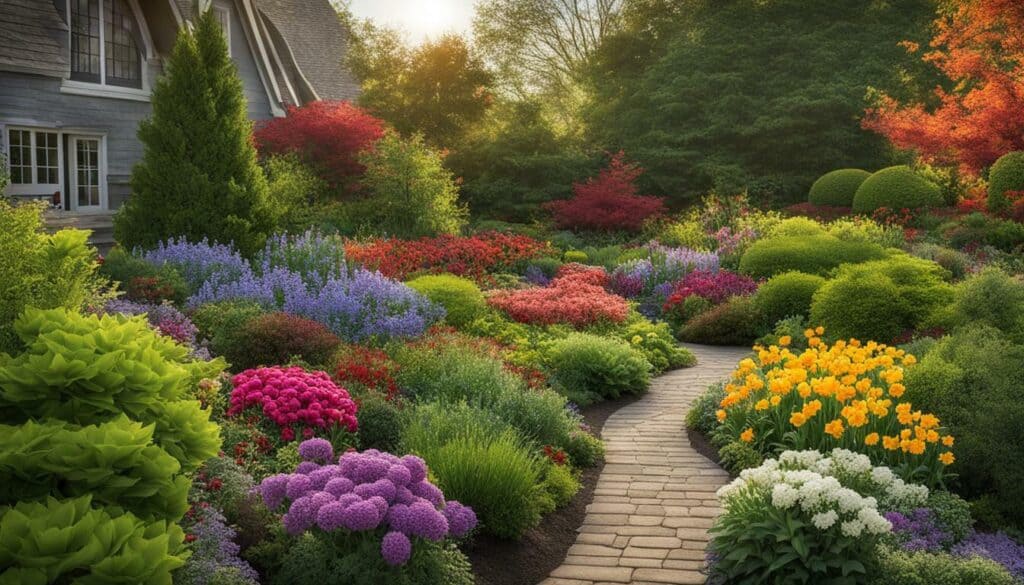
Using Bulbs for Spring Color
Add a burst of color to your garden in the spring by incorporating bulbs that bloom with vibrant hues. Daffodils are a popular choice for early spring with their cheery yellow blooms that grow well in most regions and prefer moist soil. The snapdragon is another option that comes in a variety of colors and spreads easily. If you want to add color without going overboard, ornamental cabbage may be a great choice for more traditional gardens.
Hyacinths and daylilies are also excellent choices for adding vibrant hues to your garden. Dogwood trees offer stunning blooms in pink or white, while poppies are drought-tolerant and bring a punch of color. Finally, iris flowers come in a wide array of colors and can be a low-maintenance option for your garden. These bulbs will add beauty and vibrancy to your outdoor space throughout the spring season.
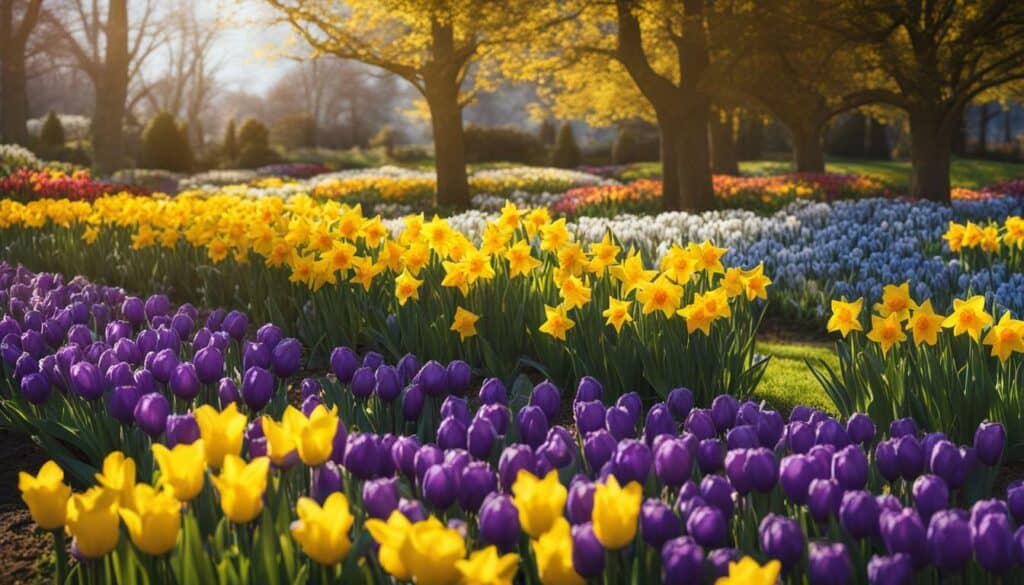
Utilizing Perennials, Shrubs, Evergreens, and Annuals for Continuous Color
Achieve continuous color in your garden by strategically incorporating a combination of perennials, shrubs, evergreens, and annuals. Perennials are a great choice for creating a strong foundation of color that returns every year. Sweet peas, for example, offer gorgeous blooms and a lovely scent that can fill your garden with color and fragrance. They’re also easy to grow and maintain, making them an excellent choice for beginners.
Shrubs are another great option for adding color and structure to your garden. VIBE ‘Ignition Purple’ salvia is a stunning option that can thrive in full sun or partial shade. Violas are also a great choice, particularly for cooler climates or as a ground cover. Coleus is another shrub that offers beautiful foliage in shades of green, purple, and pink.
Evergreens are a must-have for any garden, especially for winter interest. Lavender, for example, offers beautiful purple blooms and fragrant foliage that can last for months. Jolt Pink dianthus is another great option, providing bright pink blooms that can last well into the fall.
Annuals are a great way to add pops of color throughout your garden. Sunflowers are always a favorite, adding a cheerful burst of yellow to any landscape. Blackbeard penstemon is another great option, featuring dark foliage and deep purple blooms. For something a little more unique, consider ‘Pretty Pistachio’ and ‘Appletini’ coralbells or lamium with its silver foliage and pink accents.
Another way to add interest and color to your garden is to appreciate the beauty of foliage, berries, bark, and stems. Russian sage, for example, offers beautiful silver foliage and purple flowers that can last well into the fall. Very Berry creeping wintergreen is another great option, offering bright red berries that can last throughout the winter. Mint Julep annual geranium is a great choice for its bright green foliage and pink flowers. And lastly, bee balm and mock orange can provide striking colors and textures in the form of flowers and fruit.
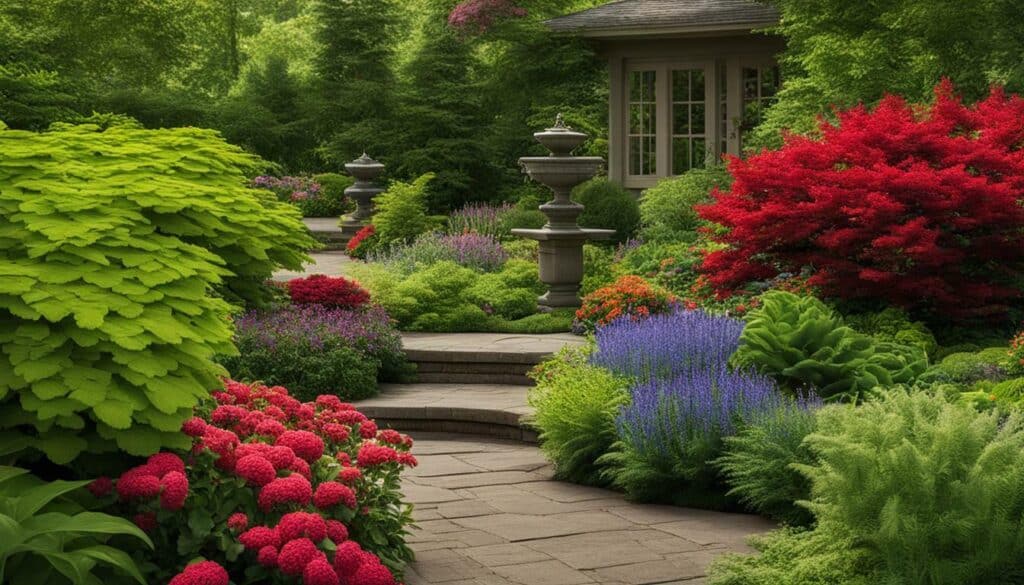
Shopping for plants in different seasons is also important to keep your garden blooming throughout the year. Spring bulbs are a great way to add early color, with options like tulips and daffodils providing a stunning display. Perennials can then take over for the rest of the season, with options like snapdragons and hyacinths providing vibrant colors throughout. Shrubs can provide structure and color for years to come, with options like hydrangeas and lilacs offering beautiful blooms every year.
Utilizing evergreens is another great way to add color and interest to your garden, particularly during the winter months. Incorporating a variety of colors and textures can create a stunning display, with options like holly and yew providing color and structure all year long.
Incorporating pollinator-friendly plants is also important to enhance the overall vibrancy of your garden. Daffodils, snapdragons, and hyacinths are all great options for attracting beneficial pollinators like butterflies and bees. By adding these plants to your garden, you can not only boost its color and visual appeal but also contribute to the health and preservation of our ecosystem.
Emphasizing Foliage Color and Other Points of Interest
Don’t overlook the power of foliage color, berries, bark, and stems in creating an eye-catching and visually diverse garden. When choosing plants, it’s important to consider their overall appearance, not just their flowers.
Plants like sweet pea, Viola, coleus, lavender, and dianthus offer colorful foliage and flowers, while shrubs like hibiscus and dogwood add seasonal interest.
Perennials like snapdragons and daylilies provide continuous color, and ornamental cabbage and hyacinth add unique textures. For a pop of color, consider Very Berry Creeping Wintergreen, which boasts bright red berries and glossy, green leaves.
In addition to foliage, adding plants with interesting bark, stems, and berries can add even more visual interest to your garden. Red twig dogwood has bright red bark that stands out in winter, while the bright yellow stems of Flame Willow make a statement in any season.
Adding pollinator-friendly plants like iris and poppies can attract bees and butterflies while adding even more color to your garden.
By incorporating these plants and paying attention to foliage color and other points of interest, your garden can become a vibrant oasis that is visually appealing throughout the year.
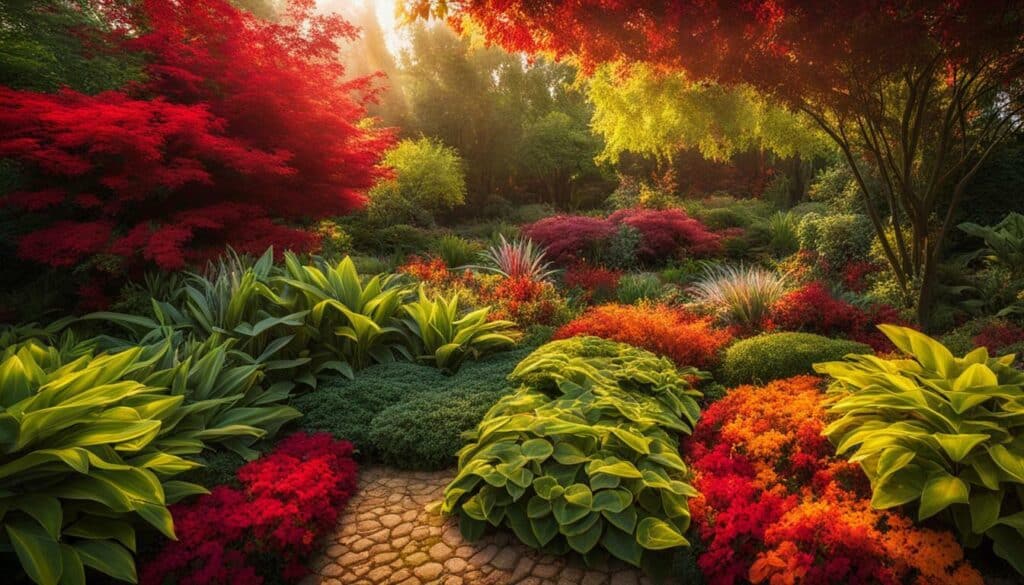
Including Pollinator-Friendly Plants for a Colorful Garden
Enhance the color and vitality of your garden by including pollinator-friendly plants that attract beneficial insects and birds. Not only do these plants add vibrant colors, but they also support the ecosystem by providing food and shelter for pollinators.
Some great options for pollinator-friendly plants include sweet peas, salvia hybrids, violas, coleus, lavender, dianthus, sunflowers, penstemon, coralbells, lamium, Russian sage, creeping wintergreen, mint julep geraniums, bee balm, and mock orange. These plants thrive in various climate zones and require different levels of sun and soil moisture, so be sure to choose the plants that are best suited for your specific garden.
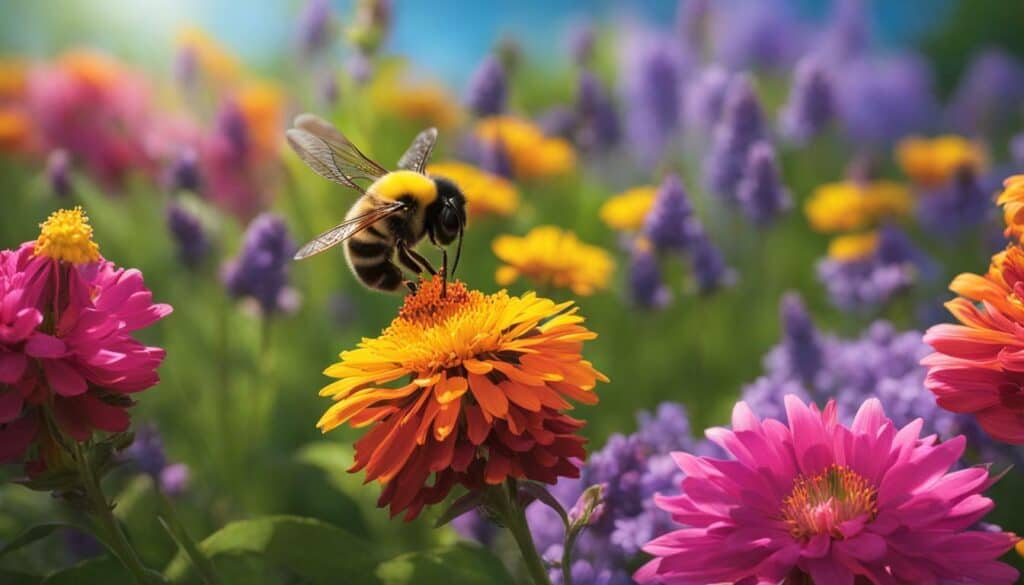
Incorporating pollinator-friendly plants in your garden is a great way to add color while also supporting the environment. Annuals like snapdragons and ornamental cabbage can provide continuous color, while daylilies, dogwood trees, hyacinths, poppies, and iris also add beauty to your garden. By selecting plants that support pollinators, your garden will not only be beautiful but it will also contribute to the health of our planet.
Tips for Choosing Plants for Your Garden
When choosing plants for your garden, it’s important to consider factors such as sunlight requirements, soil conditions, and the overall aesthetic you want to create. Here are some tips to keep in mind:
- Consider shopping for plants in different seasons to have a garden that is always colorful. Spring-blooming bulbs such as daffodils can provide early color and can be paired with late-emerging perennials to hide dying foliage.
- Choose perennials for continuous color in your garden. Make a list of perennials you want to include based on their bloom times and preferred sunlight conditions.
- Don’t overlook the use of shrubs for continuous color. They offer colorful flowers, foliage, fruit, and interesting forms.
- Evergreens can add color to your winter garden through their foliage. There are evergreens available for every purpose and season.
- Annuals provide long-lasting color. Choose easy-care varieties that bloom from spring to fall.
- Colorful foliage plants such as coleus, caladiums, and ornamental grasses can add visual interest to your garden throughout the season.
- Consider incorporating plants with colorful berries, interesting bark, or vibrant stems.
- Include pollinator-friendly plants in your garden to attract bees and butterflies.
- Choose flowers like daffodils, snapdragons, ornamental cabbage, hyacinths, poppies, iris, and hibiscus for their vibrant colors, easy maintenance, and adaptability to different climate zones.
By keeping these tips in mind and using a garden plant selection guide, you can choose plants that will thrive in your garden and provide vibrant color year-round. Remember to also consider the maintenance needs of each plant and choose varieties that suit your level of experience and available time.
Importance of Care and Maintenance for Vibrant Plants
To maintain vibrant and healthy plants in your garden, it’s essential to provide proper care and maintenance. Whether you have perennials, annuals, or shrubs, following these guidelines can help ensure your plants stay healthy and vibrant.
One critical factor in caring for vibrant plants is selecting the right plants for your specific climate and location. Consider the hardiness zones and light requirements of the plants, as well as the type of soil they prefer. This will help ensure that your plants receive the optimal growing conditions they need to stay healthy and vibrant.
Regular watering is also crucial for maintaining vibrant plants. While the watering needs may vary depending on the plant, it’s important to consistently provide water to keep the soil moist. However, it’s equally important not to overwater, as this can lead to root rot or other issues. Finding the right balance is crucial for the health of your plants.
Fertilizing your plants is another key factor in their overall health and vibrancy. Using a balanced fertilizer or organic compost can provide essential nutrients that plants need to grow and thrive. Be sure to follow the instructions on the fertilizer package and apply it at the appropriate times for optimal results.
Pruning and deadheading are also critical tasks for maintaining vibrant plants. Regularly removing dead or damaged leaves, flowers, and stems can improve the appearance of your plants and encourage new growth. Pruning can also help shape your plants and prevent them from becoming overgrown or leggy.
Protecting your plants from pests and diseases is equally important for care and maintenance. Regularly inspecting your plants for signs of pests or diseases, such as aphids or powdery mildew, can help catch and address issues early on. Using organic pest control methods or consulting a professional can help ensure that your plants stay healthy and vibrant.
Finally, paying attention to the changing seasons and making appropriate adjustments to your care routine is crucial for maintaining vibrant plants. Plants may have different needs during different seasons, such as increased watering during hot summer months or protection from frost during the winter. By staying attentive to these changes and adapting your care routine accordingly, you can help your plants thrive year-round.
In conclusion, caring for and maintaining vibrant plants requires attention to various factors such as selecting the right plants, providing proper watering and fertilization, pruning and deadheading, protecting against pests and diseases, and adapting care routines to seasonal changes. By following these practices, you can enjoy a garden filled with vibrant and healthy plants that bring beauty and joy to your outdoor space.

Conclusion
Creating a vibrant and colorful garden is within your reach by selecting the right plants, planning for different seasons, and incorporating various types of foliage, pollinator-friendly plants, and points of interest. With these tips and recommendations, your garden will become a captivating oasis of color and life.
Recommended Plants
Some recommended plants for a colorful garden include daffodils, coleus, hibiscus, snapdragons, ornamental cabbage, daylilies, dogwood trees, hyacinths, poppies, and irises. These plants provide a range of colors and growth habits to add interest and beauty to any garden space.
Shopping for Plants in Different Seasons
It is important to consider different seasons when choosing plants for your garden. Depending on the time of year, certain plants will thrive better in your climate. Do some research to determine which plants will do well in each season and plan accordingly.
Using Bulbs for Spring Color
Bulbs can add vibrant color to your garden in the spring. Some popular bulb options include tulips, daffodils, and hyacinths. Be sure to plant bulbs in the fall so they have time to establish their roots before winter.
Utilizing Perennials, Shrubs, Evergreens, and Annuals for Continuous Color
By incorporating a mix of perennials, shrubs, evergreens, and annuals, you can ensure your garden has continuous color throughout the year. Choose plants that have different blooming periods so that there is always something in bloom.
Emphasizing Foliage Color and Other Points of Interest
Don’t forget to consider foliage color and other points of interest in your garden. Plants with colorful foliage, berries, bark, and stems can add visual interest and diversity to your garden space.
Including Pollinator-Friendly Plants for a Colorful Garden
Choosing pollinator-friendly plants can not only add color to your garden but also attract beneficial pollinators. Bees, butterflies, and hummingbirds are attracted to brightly colored flowers, so be sure to include some in your garden.
Tips for Choosing Plants for Your Garden
When choosing plants for your garden, it is important to consider factors such as sunlight requirements, soil conditions, and the overall theme or style you want to achieve. Do some research and plan ahead to ensure you select the right plants for your space.
Importance of Care and Maintenance for Vibrant Plants
Proper care and maintenance are essential for vibrant and healthy plants. Be sure to water and fertilize your plants regularly, prune them when needed, and keep an eye out for pests and diseases. With the right care, your garden will continue to thrive and bloom year after year.
How Can Following Home Gardening Practices Help My Plants Grow with Vibrant Color?
By following home gardening practices, you can ensure lush greens in your plants. Implement proper watering techniques, use organic fertilizers, and provide adequate sunlight to promote vibrant colors. Regular pruning, mulching, and pest control will further enhance plant growth and help you achieve a visually appealing garden. Start practicing home gardening for lush greens and watch your plants thrive with striking colors.
What Herbs and Vegetables Can I Plant to Enhance the Flavors of My Dishes?
Enhance the flavors of your dishes with garden basil and tomato lays. These versatile herbs and vegetables can be grown at home, allowing you to add a fresh touch to your cooking. Whether it’s adding a sprinkle of basil to a pasta dish or using juicy tomatoes in a salad, cultivating these ingredients in your garden will elevate the taste of your meals to the next level.
FAQ
Q: How do I select the right plants for my garden?
A: When choosing plants for your garden, consider factors such as sunlight requirements, soil conditions, and the overall theme or style you want to achieve. It’s important to select plants that are well-suited to your garden’s specific conditions.
Q: What are some recommended plants for vibrant color in my garden?
A: Recommended plants for vibrant color include sweet pea, VIBE ‘Ignition Purple’ Salvia, viola, coleus, lavender, Jolt Pink Dianthus, sunflower, Blackbeard Penstemon, ‘Pretty Pistachio’ and ‘Appletini’ Coralbells, lamium, Russian sage, Very Berry creeping wintergreen, Mint Julep Annual Geranium, bee balm, and mock orange. These plants offer a variety of colors and textures to enhance your garden’s visual appeal.
Q: Can I shop for plants in different seasons?
A: Absolutely! Shopping for plants in different seasons allows you to add color and interest to your garden throughout the year. Consider planting seasonal plants that thrive in specific seasons to keep your garden vibrant and ever-changing.
Q: How can I add spring color to my garden?
A: Bulbs are a great way to add vibrant spring color to your garden. Plant popular bulb options such as tulips, daffodils, and hyacinths, and enjoy their beautiful blooms when spring arrives.
Q: What types of plants provide continuous color in my garden?
A: To achieve continuous color, consider incorporating a mix of perennials, shrubs, evergreens, and annuals in your garden. Perennials will come back year after year, while shrubs and evergreens provide long-lasting foliage and structure. Annuals, on the other hand, offer vibrant blooms for a single season.
Q: Can foliage color and other points of interest enhance my garden?
A: Absolutely! Foliage color plays a significant role in creating a vibrant garden. Additionally, incorporating plants with interesting berries, bark, and stems adds visual interest and diversity to your garden, creating a more dynamic and appealing landscape.
Q: Why should I include pollinator-friendly plants in my garden?
A: Including pollinator-friendly plants not only adds color to your garden but also helps attract beneficial pollinators such as butterflies and bees. These pollinators play a crucial role in plant reproduction and contribute to the overall health and vibrancy of your garden.
Q: How do I choose the right plants for my garden?
A: To choose the right plants for your garden, consider factors such as sunlight requirements, soil conditions, and the overall style or theme you want to achieve. Research different plant options and evaluate how well they align with your garden’s specific needs and preferences.
Q: How important is care and maintenance for vibrant plants?
A: Care and maintenance are essential for keeping your plants vibrant and healthy. Provide proper watering, fertilization, and pruning as needed. Regularly monitor your plants for signs of pests or diseases and take appropriate action to prevent and treat any issues that arise.
Source Links
- https://www.provenwinners.com/learn/top-ten-lists/how-plant-your-garden-continuous-color
- https://www.newhomesource.com/learn/best-plants-add-spring-color-new-homes-yard/
- https://www.familyhandyman.com/list/49-colorful-plants-to-brighten-up-your-landscape/
- https://www.bloomingbackyard.com/plants-with-colorful-foliage/
- https://www.bhg.com/gardening/flowers/perennials/top-perennials-for-your-garden/
- https://extension.uga.edu/publications/detail.html?number=C943&title=vegetable-garden-calendar
- https://ginghamgardens.com/plant-shopping-101/
- https://gardengoodsdirect.com/blogs/news/ultimate-guide-to-seasonal-gardening
- https://www.bobvila.com/articles/bulbs-to-plant-in-spring/
- https://www.bhg.com/gardening/flowers/bulbs/planting-charts-for-spring-flowering-bulbs/
- https://blog.dutchbulbs.com/bulbs-to-plant-in-spring/
- https://www.bhg.com/gardening/flowers/annuals/annual-plant-pairing-ideas/
- https://www.homesandgardens.com/gardens/best-evergreen-shrubs
- https://www.gardendesign.com/plants/foliage.html
- https://www.bhg.com/gardening/design/color/color-in-the-garden/
- https://homesteadandchill.com/top-23-plants-for-pollinators/
- https://www.allaboutgardening.com/pollinator-garden-plants/
- https://www.homesandgardens.com/gardens/plants-for-pollinators
- https://www.gardenersoasis.com/pick-the-right-plants/
- https://www.realhomes.com/advice/how-to-choose-plants-for-your-garden
- https://www.thespruce.com/plant-selection-for-the-landscape-2131865
- https://chippewavalleygrowers.com/the-importance-of-plant-maintenance/
- https://www.finegardening.com/article/10-ways-to-keep-your-garden-healthy
- https://extension.psu.edu/care-and-maintenance-of-perennials
- https://growingourown.wordpress.com/6-conclusion/
- http://lizfabry.blogspot.com/2012/11/garden-update.html?m=1
- https://msutreehugger.weebly.com/chapter-v-conclusions-and-recommendations.html

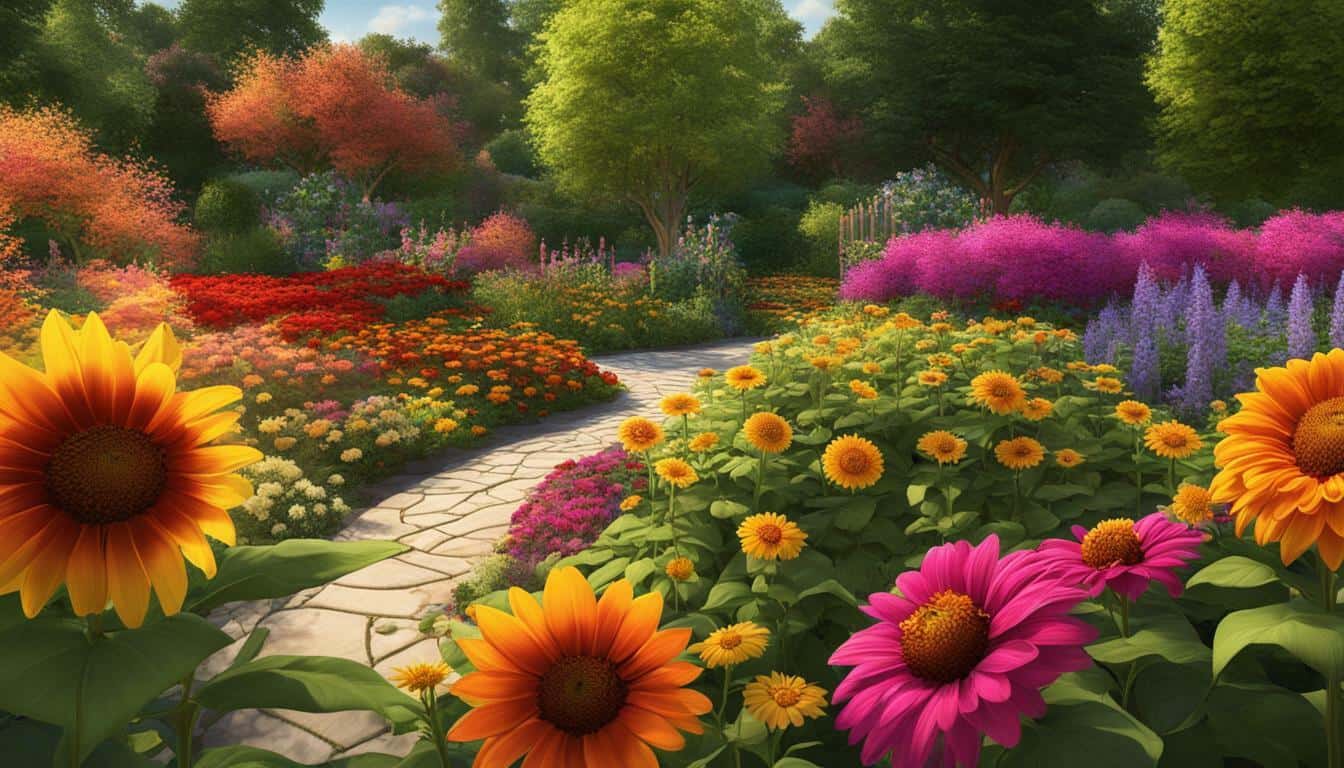



Leave a Reply